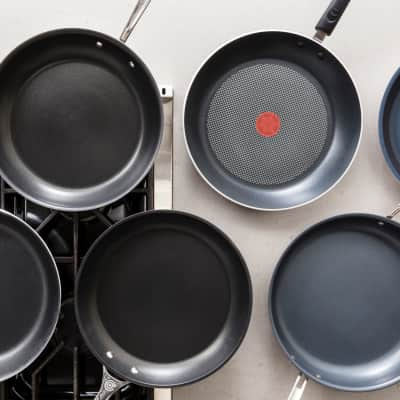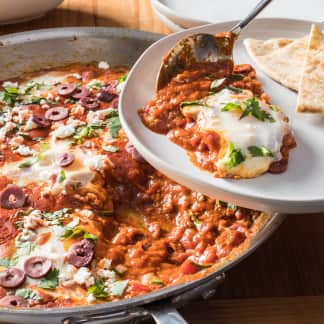Eggs are one of the most humble ingredients, and yet they make some of the most satisfying meals. After all, who doesn’t love a fluffy, flavorful scramble or a breakfast sandwich made with a gooey poached egg? In the test kitchen, we've been developing egg recipes for more than two decades, obsessing over everything from the best kind to buy to the perfect method for hard-cooked eggs that peel in seconds. Here are 12 important things we’ve learned about eggs over the years.
1. There’s an Easy Way to Remove Bits of Eggshell
Trying to fish pieces of shell out of a raw egg with your fingers or a fork is usually futile because the broken bits cling to the egg white. Instead, use the eggshell that you just cracked in half to scoop them up. You can do the same to remove strands of stray yolk too. But to avoid bits of shell getting into the egg in the first place, we recommend cracking the egg on a flat surface rather than on the edge of a bowl or the side of the counter.
2. Use Half-and-Half for the Fluffiest Scrambled Eggs
The dairy-in-scrambled-eggs debate goes back decades, but test kitchen editor Dan Souza found a definitive answer when developing his recipe for Perfect Scrambled Eggs. With its combination of fat and water, dairy creates steam that helps puff up eggs, giving you a richer, fluffier scramble. But what kind of dairy should you use? We tried making scrambled eggs with milk, half-and-half, and cream. Milk produced curds that were prone to weeping, while cream made our scramble a bit too dense. Half-and-half was a happy medium, giving us scrambled eggs with fluffiness and stability.
3. An Extra Yolk Goes a Long Way
The real secret to scrambled eggs with rich egg-y flavor? Extra yolks. For our four-serving recipe, we used eight large eggs plus two additional yolks. This prevented the flavor of the dairy from overpowering the eggs but allowed us to add enough half-and-half to keep our eggs puffy and stable.

4. For a Tender Scramble, Add Salt Before Heat
Most of us use a little salt when making scrambled eggs, but the key is adding it at the right moment. When developing his recipe, Dan found that mixing salt into the raw eggs—before they touched the hot skillet—produced more-tender curds. The reason why? Salt helps dissolve the egg proteins, making them unable to bond as tightly when cooked.
5. It’s Possible to Peel Hard-Cooked Eggs in Just Seconds
The way to get easy-to-peel hard-boiled eggs is to not boil them at all. Cook’s Illustrated senior editor Andrea Geary discovered a new way for making hard-cooked eggs that ensures the shells slip right off. The trick is to cook the eggs in hot steam—which is also how we make foolproof soft-cooked eggs. The heat breaks down the outermost proteins so that they shrink and pull away from the membrane, making the eggs much easier to peel; on the other hand, if you place eggs in a pot of cold water and then bring it to a boil, the whites set more slowly, giving them time to bind to the surrounding membrane, which equals hard-to-remove shells.

3 Ways to Use Empty Egg Cartons
1. Flipped over, two cardboard cartons become a makeshift cooling rack for a baking sheet.
2. The egg holes can be used to transport delicate pastries and hors d’oeuvres like tartlets and deviled eggs.
3. Light your grill with a cardboard egg carton. Place it in the kettle, stack up to 3 quarts of briquettes on top, and light the cardboard to start the flame.
6. Unsalted Butter is Best for Eggs
For scrambled and fried eggs (and most other recipes), we recommend cooking with unsalted rather than salted butter, even if you reduce the total amount of salt in the dish. The reason is that different brands add different amounts of salt to butter, ranging from 1.25 to 1.75 percent of the total weight. So while salted butter is great to slather on toast, scones, and corn on the cob, unsalted is usually best for cooking.
7. You Can’t Judge an Egg By Its Shell Color
If you buy farm-fresh eggs, you might get a carton with a combination of white, brown, and even blue eggs, but essentially they’re all the same. We put the eggs to the test and found no significant differences in flavor despite the different shell colors. What does matter, though, is how fresh eggs are and how the hens are raised. We compared eggs that were farm-fresh (less than a week old), organic, from vegetarian-fed chickens, and standard supermarket fare. The farm-fresh eggs stood out from the pack, with rich, complex flavor. The organic ones were our second favorite, while those from hens with a vegetarian diet came in third.
8. You Can Achieve Diner-Style Sunny-Side Up Eggs at Home
Perfect fried eggs have gooey yolks, cooked whites, and crispy, bronzed edges. Our favorite brunch and breakfast spots have it down pat, but replicating their sunny-side-up style at home takes more than just dropping an egg on a hot skillet and hoping for the best. Cook’s Illustrated senior editor Andrew Janjigian cracked the code, discovering that covering the pan with a lid, removing it from the heat after just 1 minute, and letting it sit covered for up to 2 additional minutes was the recipe for success.

9. Set Your Timer for Perfect Poached Eggs
Poaching eggs is definitely an exact science. After all, how many times have you been going for a slightly firm yet still gooey yolk and ended up with one that’s chalky and hard instead? Even 20 or 30 seconds can make a big difference, so we always set our handy kitchen timer. For the ideal consistency, we cook the eggs using our foolproof method and check them after 3 minutes. For a firmer consistency, allow the eggs to continue to cook, checking them at 30-second intervals.
10. The Temperature of Your Egg Matters
When developing his recipe for scrambled eggs, Dan found no difference in using straight-from-the-fridge eggs versus those that had warmed to room temperature. But sometimes, cold eggs can cause problems, like in pound cake or chiffon cake. Since these recipes rely on air beaten into the eggs to give the cake lift, cold eggs—which don’t whip as well—can result in denser cake. So our rule of thumb is to follow a recipe; if it calls for room-temperature eggs, there’s probably a good reason. Be sure to let your eggs sit out for an hour or place them in a bowl of warm water for about 5 minutes before you start cooking. Otherwise, you can leave eggs in the refrigerator until you’re ready to use them.
11. Baked Eggs Need Time to Rest
Scrambled and fried eggs are an everyday affair, but baked eggs make an elegant addition to a special-occasion brunch. To get them to come out flawless every time, we found that you need to remove them from the oven before the whites set, otherwise you’ll end up with dreaded overdone yolks. So, we cook the raw eggs in hot, filling-lined ramekins for 6 to 8 minutes. When the whites are opaque but still jiggly, we remove the ramekins and let them sit for 10 minutes before serving.

12. You Should Take Sell-By Dates With a Grain of Salt
Pick up a carton of eggs at the supermarket and you’ll notice two numbers on it: the sell-by date and the pack date. The sell-by date is within 30 days of the pack date and is a vague guideline about freshness; the U.S. Department of Agriculture says eggs can be consumed three to five weeks past this date. Then there’s the pack date—it’s a number between 001 and 365, representing the days between January 1 and December 31—which signals when the eggs were graded and packed, usually within a week of being laid but sometimes up to 30 days later. With all these numbers and different interpretations, how do you know if eggs are too old to use? We did some research in the test kitchen and found that two- and three-month-old eggs still tasted good. At four months, they were edible but the whites and yolks had loosened, meaning they weren’t ideal for baking. When in doubt, give your eggs a sniff. If they smell odd or are discolored, throw them out.
What's your favorite way to cook eggs? Let us know on Twitter @testkitchen with #CooksIllustrated.
Be first to know about new stories! Sign up for our newsletter for revolutionary recipes and insightful reviews.
More from Cook's Illustrated

Perfect Fried Eggs
A classic fried egg features a tender white with crisp, lacy, brown edges and a fluid but lightly thickened yolk. Could we crack the code to making a perfect one?
Get the Recipe
Perfect Scrambled Eggs
The classic approach will never give you tender scambled eggs with big, pillowy curds. But acheiving that goal takes more than just turning up the heat.
Get the Recipe
Easy-Peel Hard-Boiled Eggs
You no longer need to fear the drudgery of peeling hard-boiled eggs—with the right cooking method, the shells practically fly off.
Get the Recipe
Perfect Poached Eggs
The most vexing problem with poached eggs is keeping the whites neat and tidy. Gimmicky methods abound, but a few simple tricks and tools are all you need.
Get the Recipe
The Best 12-Inch Nonstick Skillets
Step 1: Buy the best skillet. Step 2: Treat it right.
Read Our Review
The Best 12-Inch Enameled Cast-Iron Skillets
Cheap and tough, a cast-iron skillet is a kitchen workhorse, but the upkeep makes some cooks balk. Could enameled cast-iron pans, which need no special care, top the classic?
Read Our Review
The Best Slotted Spoons
We rounded up eight dishwasher-safe nylon, silicone, and stainless-steel spoons, and used them to fish out green peas, poached eggs, meatballs, and jumbo shrimp from liquids in different kinds of cookware.
Read Our ReviewThe Best Silicone Spatulas
A spatula should feel like an extension of your arm, nimbly stirring, scraping, and folding any food you put in its path. Why is a good one so hard to find?
Read Our Review
Perfect Scrambled Eggs for Two
The classic approach will never give you tender scambled eggs with big, pillowy curds. But acheiving that goal takes more than just turning up the heat.
Get the Recipe
French Onion and Bacon Tart
French Onion Tart is similar to quiche but delivers a more refined slice of pie, with more onions than custard. The problem? Rolling and fitting the dough into a tart pan.
Get the Recipe
Soft-Boiled Eggs
The usual approach is hit or miss. We cooked more than 1,000 eggs to develop a truly reliable method that delivers a tender, set white and a fluid yolk every time.
Get the Recipe
Curry Deviled Eggs
You no longer need to fear the drudgery of peeling hard-cooked eggs—with the right cooking method, the shells practically fly off.
Get the Recipe
Baked Eggs Florentine
Ideally, this dish should feature tender whites and runny yolks—but it almost never does. We baked hundreds of eggs trying to crack the code.
Get the Recipe

Deviled Eggs with Tuna, Capers, and Chives
We set out to perfect this traditional picnic standby.
Get the Recipe
Family-Sized Tomato, Bacon, and Garlic Omelet
This omelet is big enough to serve four, but it still has the merits of an individual omelet: tender not tough eggs and a hearty filling that doesn't weigh down the eggs.
Get the Recipe
Creamy Egg Topping
The combination of cornichons, capers, and mustard gives this creamy topping for our Best Baked Potatoes some kick.
Get the Recipe
Foolproof Hollandaise Sauce
Drizzle this sauce over prepared asparagus or eggs Benedict.
Get the Recipe



















